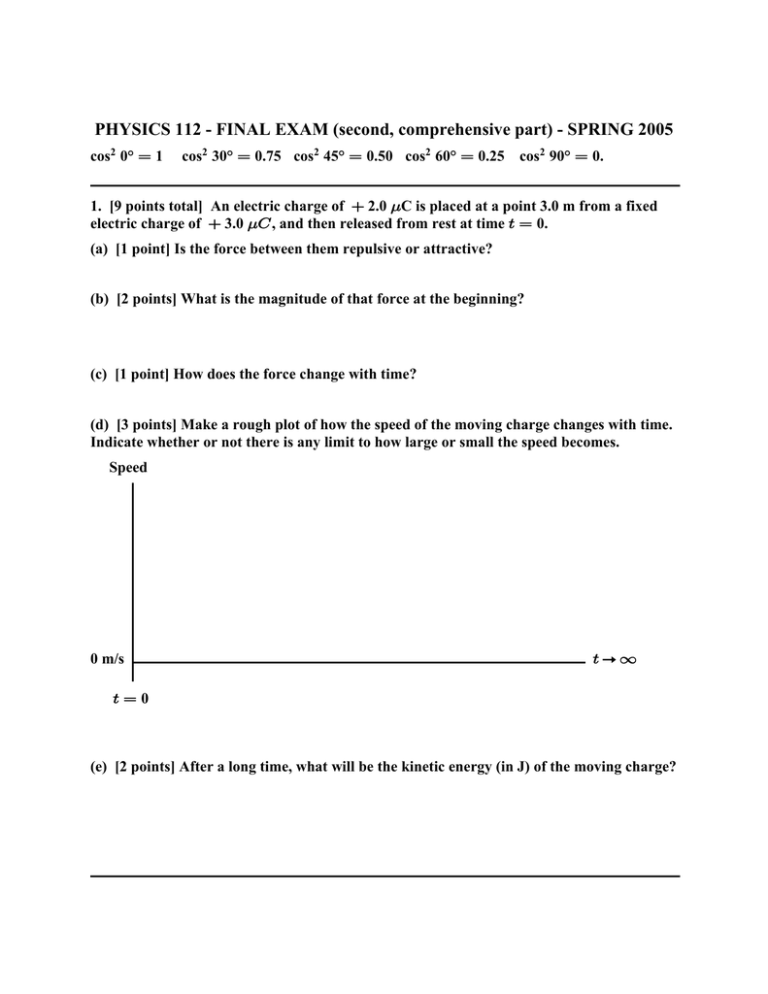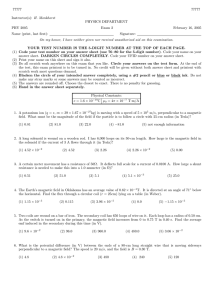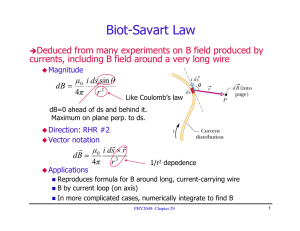PHYSICS 112 - FINAL EXAM (second, comprehensive part) - SPRING...
advertisement

PHYSICS 112 - FINAL EXAM (second, comprehensive part) - SPRING 2005 cos2 0° œ 1 cos2 30° œ 0.75 cos2 45° œ 0.50 cos2 60° œ 0.25 cos2 90° œ 0. 1. [9 points total] An electric charge of 2.0 .C is placed at a point 3.0 m from a fixed electric charge of 3.0 .G , and then released from rest at time > œ 0. (a) [1 point] Is the force between them repulsive or attractive? (b) [2 points] What is the magnitude of that force at the beginning? (c) [1 point] How does the force change with time? (d) [3 points] Make a rough plot of how the speed of the moving charge changes with time. Indicate whether or not there is any limit to how large or small the speed becomes. Speed 0 m/s >p∞ >œ0 (e) [2 points] After a long time, what will be the kinetic energy (in J) of the moving charge? t œ (1000 N/C, 2. [4 points total] (a) Suppose that the electric field at a certain point is I 500 N/C). What is the electric force produced by that field on a charge of 20 .C? (b) At a different point in space a 20 .C charge experiences an electrical force 3. [6 points total] A 15-V battery is connected in series to a 3-ohm resistor and a 2-ohm resistor. (a) [2 points] What is the current through the 3-ohm resistor? (b) [2 points] What is the power dissipated by the 2-ohm resistor? (c) [2 points] What is the total power delivered by the battery? 4. [9 points total] A square metal loop whose sides are each 0.20 m long is placed in a t of magnitude 2.0 T, as shown in the diagram. Initially uniform external magnetic field F there is no current in the loop. The loop has an electrical resistance of 5.0 H. Ft Æ (a) [3 points] Over a period of 4.0 seconds the external magnetic field is rotated from its initial position (shown) until it is straight up Ð Ñ. Determine the magnetic flux through the loop at the beginning and end of this rotation. Finitial œ ___________________________________________ Ffinal œ ___________________________________________ (b) [2 points] Determine the magnitude of the average induced current. (c) [2 points] Determine the direction ( Å , Ä , à , Æ , , or Œ ) of the induced magnetic field of the loop and the direction of the induced current (clockwise or counterclockwise). Explain your reasoning. (d) [2 points] Suppose the external magnetic field did not change its direction, but that there was a clockwise current in the loop (from a battery in its circuit, say). Would there be a net torque on the loop and, if so, how would it rotate? 5. [8 points] An object 4.0 mm high is located on the principal axis of a divergent lens whose focal points are located 12.0 cm from the lens. The object is at a distance of 18 cm from the lens. Use the lens equation to determine (with the correct signs!): the focal length 0 : ____________________ the image distance: ____________________ the magnification: ____________________ the height of the image: ____________________ the nature of the image (real or virtual): ____________________ the orientation of the image (erect or inverted): ____________________ (No diagram is necessary, but you are welcome to use one to check your answers.) 6. [4 points] Light which is perfectly polarized in the direction ) œ 30° is passed through two ideal (perfect) polarizers which transmit light in the directions ) œ 90° and ) œ 45°. R 9>/ >2/ @+6?/= 90 ><3189897/><3- 0 ?8->398= +> >2/ ,/1388381 90 >23= /B+7Þ (a) What fraction of the original light intensity passes through the first polarizer, and in which direction is it polarized? (b) What fraction of the original light intensity passes through the second polarizer, and in which direction is it polarized? SOLUTIONS to S2005 FINAL 1. [9 points total] An electric charge of 2.0 .C is placed at a point 3.0 m from a fixed electric charge of 3.0 .G , and then released from rest at time > œ 0. (a) [1 point] Is the force between them repulsive or attractive? The force is repulsive, because the two charges have the same sign. (b) [2 points] What is the magnitude of that force at the beginning? J œ 5;1 ;2 Î<2 œ Ð9 ‚ 109 N m2 C2 ÑÐ2 ‚ 106 CÑÐ3 ‚ 106 CÑÎÐ3.0 mÑ2 œ œ 6 ‚ 103 N œ 0.006 N or 6 mN. (c) [1 point] How does the force change with time? The force decreases with time, continuously becoming smaller in magnitude. (d) [3 points] Make a rough plot of how the speed of the moving charge changes with time. Indicate whether or not there is any limit to how large or small the speed becomes. Speed 0 m/s >p∞ >œ0 The speed starts at 0 at time > œ 0.0 s, rises with decreasing slope, and finally approaches a limit from below. (e) [2 points] After a long time, what will be the kinetic energy (in J) of the moving charge? After a long time, when the second charge is so far away that its potential energy is zero, its kinetic energy must be equal to the initial electric potential energy of the pair of charges: 5;1 ;2 Î< œ Ð9 ‚ 109 N m2 C2 ÑÐ 2.0 ‚ 106 CÑÐ 3.0 ‚ 106 CÑÎÐ3.0 mÑ œ 18 ‚ 103 J or 0.018 J. t œ (1000 N/C, 2. [4 points total] (a) Suppose that the electric field at a certain point is I 500 N/C). What is the electric force produced by that field on a charge of 20 .C? Jt œ ;It œ Ð20 ‚ 106 CÑÐ1000 N/C, 500 N/CÑ œ Ð0.020 N, 0.010 NÑ (b) At a different point in space a 20 .C charge experiences an electrical force t œ (1.0 ‚ 104 N, 0). What is the electric field at that point? J It œ Jt Î; œ Ð1.0 ‚ 104 N, 0ÑÎÐ 20 ‚ 106 CÑ œ Ð 5.0 N/C, 0Ñ 3. [6 points total] A 15-V battery is connected in series to a 3-ohm resistor and a 2-ohm resistor. (a) [2 points] What is the current through the 3-ohm resistor? The equivalent resistance V eq œ 3 H 2 H œ 5 H so the current in the circuit is M œ Ð15 VÑÎÐ5 HÑ œ 3 A. This is the current through the 3- and the 2-ohm resistors. (b) [2 points] What is the power dissipated by the 2-ohm resistor? This is T œ M 2 V œ Ð3 AÑ2 Ð2 HÑ œ 18 W. (c) [2 points] What is the total power delivered by the battery? The total power delivered by the battery is M ?Z œ Ð3 AÑÐ15 VÑ œ 45 W. 4. [9 points total] A square metal loop whose sides are each 0.20 m long is placed in a t of magnitude 2.0 T, as shown in the diagram. Initially uniform external magnetic field F there is no current in the loop. The loop has an electrical resistance of 5.0 H. Ft Æ (a) [3 points] Over a period of 4.0 seconds the external magnetic field is rotated from its initial position (shown) until it is straight up Ð Ñ. Determine the magnetic flux through the loop at the beginning and end of this rotation. Finitial œ ___________________________________________ Ffinal œ ___________________________________________ Initially F œ FE cos ) œ Ð2.0 TÑÐ0.20 mÑ2 cos Ð90°Ñ œ 0 since the external magnetic field and the normal to the loop are perpendicular to each other. Finally F œ FE cos ) œ Ð2.0 TÑÐ0.20 mÑ2 cos Ð0°Ñ œ 0.08 T † m2 since the external magnetic field and the normal to the loop are in the same direction. (b) [2 points] Determine the magnitude of the average induced current. M œ Ð?FÎ?>ÑÎV œ Ð0.08 T † m2 /4.0 sÑ/Ð5.0 H) œ 0.0040 A or 4.0 mA. (c) [2 points] Determine the direction ( Å , Ä , à , Æ , , or Œ ) of the induced magnetic field of the loop and the direction of the induced current (clockwise or counterclockwise). Explain your reasoning. The flux due to the external magnetic field will be up out of the page Ð Ñ and increasing in magnitude, so by Lenz' law the magnetic field due to the induced current must oppose that change and be in the direction down into the page Ð Œ ÑÞ The induced current must then, by the right-hand rule, be clockwise. (d) [2 points] Suppose the external magnetic field did not change its direction, but that there was a clockwise current in the loop (from a battery in its circuit, say). Would there be a net torque on the loop and, if so, how would it rotate? In this case the magnetic field of the current loop would be directed up down into the page ( Œ ), which would be 90° from the direction of the external magnetic field. Thus there would be a net torque. The loop would rotate so its magnetic field lined up with the external magnetic field: it would rotate so its top edge went down into the page and its bottom edge went up out of the page; this would appear to be a clockwise rotation viewed from the right or a counterclockwise rotation viewed from the left. 5. [8 points] An object 4.0 mm high is located on the principal axis of a divergent lens whose focal points are located 12.0 cm from the lens. The object is at a distance of 18 cm from the lens. Use the lens equation to determine (with the correct signs!): the focal length 0 : ____________________ the image distance: ____________________ the magnification: ____________________ the height of the image: ____________________ the nature of the image (real or virtual): ____________________ the orientation of the image (erect or inverted): ____________________ (No diagram is necessary, but you are welcome to use one to check your answers.) 0 œ 12.0 cm and 9 œ 18 cm from the statement of the problem. 1/3 œ 1/0 1/9 œ 1Î( 12 cm) 1/(18 cm) œ 3/36 cm 2/36 cm œ 5/36 cm so 3 œ (36/5) cm œ 7.2 cm. 7 œ 3Î9 œ Ð 7.2 cmÑÎ18 cm œ 0.40. The height of the image is 7Ð4.0 mmÑ œ (0.40)Ð4.0 mmÑ œ 1.6 mm. The image is virtual and erect. 6. [4 points] Light which is perfectly polarized in the direction ) œ 30° is passed through two ideal (perfect) polarizers which transmit light in the directions ) œ 90° and ) œ 45°. R 9>/ >2/ @+6?/= 90 ><3189897/><3- 0 ?8->398= +> >2/ ,/1388381 90 >23= /B+7Þ (a) What fraction of the original light intensity passes through the first polarizer, and in which direction is it polarized? The first polarizer transmits a fraction cos2 (90° 30°) œ cos2 (60°) œ Ð1Î2Ñ2 œ 1Î4 or 25% of the original light, and it is now polarized in the direction ) œ 90°. (b) What fraction of the original light intensity passes through the second polarizer, and in which direction is it polarized? The second polarizer transmits a fraction cos2 (45° 90°) œ cos2 ( 45°) œ Ð1ÎÈ2Ñ2 œ 1Î2 of what struck it, or (1/2) ‚ 25% œ 12.5% of the original light, and it is now polarized in the direction ) œ 45°.






